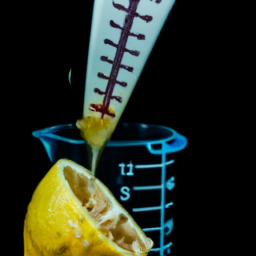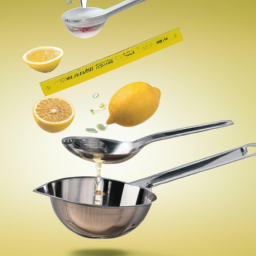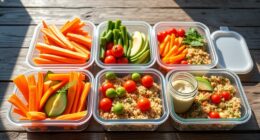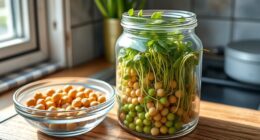As a person who delights in starting my day with a cool glass of orange juice, I frequently ponder the shelf life of this beverage when kept in the refrigerator. Freshly squeezed orange juice offers both delectable taste and health benefits, yet it is prone to rapid spoilage if not correctly preserved.
In this article, I will explore the factors that determine the shelf life of fresh orange juice, how to store it correctly, and how to tell if it has gone bad. The shelf life of fresh orange juice depends on several factors, including the quality of the oranges, the method of extraction, and the storage conditions.
If the oranges are ripe and free of mold and rot, the juice will have a longer shelf life. The method of extraction also plays a role; juice that is extracted using a cold press machine will last longer than juice that is squeezed with a handheld juicer. Proper storage is crucial to extending the shelf life of fresh orange juice.
By understanding these factors, we can ensure that our orange juice stays fresh and delicious for as long as possible.
Key Takeaways
- Fresh orange juice lasts for about 2-3 days in the fridge.
- To extend the shelf life, transfer the juice to an airtight container, store in the coldest part of the fridge, avoid exposure to light and air, and consider adding lemon juice or freezing in ice cube trays.
- Preservatives such as ascorbic acid, citric acid, and potassium sorbate can also be added to prevent spoilage, bacteria growth, and deterioration.
- Signs of spoilage include a cloudy appearance, sour or musty odor, and off taste.
What Determines the Shelf Life of Fresh Orange Juice
You’re probably wondering how long your fresh orange juice will last in the fridge, and the answer lies in what determines its shelf life. The shelf life of fresh orange juice is dependent on several factors affecting its quality, including the storage conditions.
The primary factors include the type of oranges used, the processing method, and the storage temperature. The type of oranges used in making the juice can affect its shelf life. Some oranges have a higher acidity level, which can help preserve the juice for a longer period.
The processing method can also impact the shelf life of the juice. Freshly squeezed orange juice has a shorter shelf life compared to pasteurized orange juice. Finally, the storage temperature can affect the shelf life of the juice. Storing the juice at the right temperature can help maintain its freshness for a longer period.
Now that we’ve established the factors affecting the shelf life of fresh orange juice, let’s talk about how to store it properly.
How to Store Fresh Orange Juice
To keep your OJ tasting its best, make sure to store it properly in the refrigerator. The first tip is to transfer the fresh orange juice from its original container to an airtight container. This will prevent any air from seeping in and oxidizing the juice, which can cause it to spoil faster.
Additionally, it’s best to store the container in the coldest part of the fridge, which is usually the back of the bottom shelf. This will ensure that the juice stays fresh for longer. Another important factor to consider when storing fresh orange juice is its nutritional value.
Orange juice is a great source of vitamin C, potassium, and other essential nutrients. However, exposure to light and air can degrade these nutrients over time, which can reduce the health benefits of the juice. By following proper storing techniques, you can preserve the nutritional value of the juice and enjoy its full benefits.
Now, let’s discuss the signs that fresh orange juice has gone bad.
Signs that Fresh Orange Juice has Gone Bad
When it comes to fresh orange juice, it’s important to know the signs that it has gone bad. As someone who enjoys starting my day with a glass of orange juice, I pay attention to its appearance, smell, and taste.
If the juice looks cloudy, smells sour, or tastes off, it’s time to toss it out.
Appearance
After a few days in the fridge, fresh orange juice may start to look cloudy or separate. This change in appearance is due to the natural settling of pulp and other solids that are present in the juice. The color intensity may also become duller as the juice begins to lose its freshness.
Additionally, sediments may begin to form at the bottom of the container, which is a sign that the juice is no longer at its peak quality. When it comes to determining the freshness of orange juice, appearance is only one factor to consider.
The next step is to evaluate the smell of the juice. A stale or musty odor is a clear indication that the juice has gone bad and should be discarded.
Smell
Take a whiff of the orange juice before drinking it to ensure that it doesn’t have a stale or musty odor, which would mean it’s no longer good. The smell of orange juice is one of the most important indicators of its freshness. If the juice smells sour or rotten, then it’s time to throw it out.
To keep your orange juice smelling fresh, there are a few ways to freshen up the smell of your fridge. One way is to clean your fridge regularly with a mixture of water and vinegar. This will help eliminate any unpleasant odors that may be lingering in your fridge.
Another way is to use natural remedies such as placing a bowl of baking soda in your fridge to absorb any odors. Additionally, you can use benefits of aromatherapy by adding a few drops of essential oils such as lemon or lavender to a cotton ball and placing it in your fridge. This will not only help freshen up the smell of your fridge but also create a calming and relaxing environment in your kitchen.
As important as the smell of orange juice is, the taste is equally important.
Taste
You’ll want to savor the delicious flavor of this zesty drink to fully appreciate its tangy notes and refreshing taste.
Fresh orange juice has a unique flavor profile that is both sweet and tart, with hints of acidity that make it a perfect addition to any breakfast or brunch table.
Here are some recipe ideas to make the most of your fresh orange juice:
- Whip up a batch of orange juice pancakes, using fresh juice in the batter for a burst of citrus flavor.
- Mix fresh orange juice with honey and ginger for a refreshing and healthy morning drink.
- Add fresh orange juice to your smoothies for an extra boost of vitamin C and a bright, tangy taste.
- Use fresh orange juice to make a marinade for chicken or fish, adding a touch of sweetness and acidity to your dish.
- Combine fresh orange juice with sparkling water and mint for a light and refreshing mocktail.
Now that you know how to make the most of your fresh orange juice, it’s important to note how long it lasts in the fridge.
How Long Fresh Orange Juice Lasts in the Fridge
When storing fresh orange juice in your fridge, it typically lasts for about 2-3 days before it starts to spoil. This is due to the fact that fresh orange juice contains natural enzymes and bacteria that can cause it to go bad quickly.
However, there are ways to use leftover orange juice before it spoils, such as using it in smoothies, marinades, or salad dressings. If you want to make your fresh orange juice last longer without refrigeration, there are a few techniques you can try.
One of the easiest ways is to add a small amount of lemon juice to the orange juice, as the acidity can help preserve it. Another option is to freeze the orange juice in ice cube trays and use the cubes as needed.
But, if you want to extend the shelf life of fresh orange juice in the fridge, there are a few more steps you can take to keep it fresher for longer.
How to Extend the Shelf Life of Fresh Orange Juice
I’ve found that freezing fresh orange juice is a great way to extend its shelf life. Simply pour the juice into an airtight container and pop it in the freezer.
Another option is to add preservatives, such as citric acid or ascorbic acid, to the juice to prevent spoilage.
Freezing Orange Juice
If you want to make your fresh orange juice last longer, try freezing it in ice cube trays. This is a great way to preserve the juice’s nutritional value while still being able to enjoy it whenever you want.
Here are some creative recipes you can make using frozen orange juice cubes:
- Make a refreshing orange juice slushie by blending frozen orange juice cubes with ice and a little bit of honey.
- Add frozen orange juice cubes to sparkling water or club soda for a fizzy and flavorful drink.
- Use frozen orange juice cubes in marinades for chicken or fish for a tangy and citrusy flavor.
By freezing your orange juice, you can extend its shelf life by several months. However, if you want to avoid freezing your juice, you can also add preservatives to it.
Adding Preservatives
So, freezing orange juice is a great way to extend its shelf life. However, there are also other methods that can be used to keep orange juice fresh. One of these methods is adding preservatives.
Preservatives are substances added to food and drinks to prevent spoilage, bacteria growth, and other forms of deterioration. There are two types of preservatives: natural and synthetic. Natural preservatives are derived from natural sources, such as plants, while synthetic preservatives are chemically created.
Some common types of preservatives used in orange juice include ascorbic acid (vitamin C), citric acid, and potassium sorbate. While adding preservatives can help extend the life of orange juice, it’s important to note that some people prefer to avoid them due to potential health concerns.
Moving forward, it’s important to understand the health benefits of fresh orange juice.
Health Benefits of Fresh Orange Juice
Indulging in a glass of fresh orange juice not only quenches your thirst but also provides a plethora of health benefits. Oranges come in different varieties, and each has its unique nutritional value. For instance, the navel orange is an excellent source of Vitamin C, which is essential in fighting diseases and boosting the immune system.
Moreover, fresh orange juice is rich in flavonoids, which are antioxidants that help in preventing cell damage and reducing the risk of chronic diseases. Research shows that regular consumption of fresh orange juice may lower blood pressure levels, reduce inflammation, and improve heart health.
Additionally, drinking fresh orange juice can help in preventing kidney stones and reducing the risk of developing certain types of cancer. The nutritional content of fresh orange juice makes it an ideal drink for anyone looking to lead a healthy lifestyle.
If you want to enjoy fresh orange juice for longer, there are a few tips you can follow to make it last.
Tips for Making Fresh Orange Juice Last Longer
To keep your OJ from spoiling quickly, store it in an airtight container in the refrigerator and consume within 3-4 days, according to a study by the American Chemical Society. However, there are a few other tricks you can use to extend the shelf life of your orange juice. For example, adding a pinch of salt to your juice can help prevent spoilage. Additionally, freezing orange juice into ice cubes can be a great way to preserve the juice and add it to smoothies or other drinks later on.
Here’s a table that summarizes some of the ways you can make your fresh orange juice last longer:
| Tip | Description |
|---|---|
| Store in an airtight container | Prevent air exposure and keep the juice in a sealed container. |
| Add a pinch of salt | Help prevent spoilage by adding a small amount of salt to your juice. |
| Freeze into ice cubes | Preserve the juice and add it to smoothies or other drinks later on. |
| Use an antioxidant preservative | Add a preservative like Vitamin C to extend the shelf life of your juice. |
| Use leftover pulp | Use leftover pulp to make muffins, smoothies, or other baked goods. |
As you can see, there are several ways to make your orange juice last longer and reduce waste. But what about other ways to use fresh orange juice?
Other Ways to Use Fresh Orange Juice
If you’re feeling creative in the kitchen, try using that tangy, citrusy liquid in a marinade for your next meal. Fresh orange juice is a versatile ingredient that can add a burst of flavor to any dish. Here are some juice recipes and alternative uses to help you make the most of your leftover orange juice:
- Mix fresh orange juice with olive oil, honey, and Dijon mustard for a zesty salad dressing.
- Blend fresh orange juice with frozen fruits and yogurt for a refreshing smoothie.
- Bonus tip: Freeze fresh orange juice in ice cube trays to use as a smoothie booster.
With these ideas, you don’t have to let your fresh orange juice go to waste. But what if your juice has already gone bad? Don’t worry, there are ways to dispose of spoiled orange juice.
How to Dispose of Spoiled Orange Juice
When your orange juice has spoiled, you’ll need to dispose of it properly to avoid any unpleasant odors or spills. One option is to pour the spoiled juice down the drain and flush it with hot water. However, this may not be the most eco-friendly choice as it can contribute to water pollution. Another option is to compost the spoiled juice. Composting is a natural process that breaks down organic materials into a nutrient-rich soil amendment. By composting, you can reduce waste and improve the health of your garden.
Composting spoiled orange juice can have positive effects on the environment. When organic materials are sent to landfills, they decompose anaerobically, which can release methane gas into the atmosphere. Methane is a potent greenhouse gas that contributes to climate change. Composting, on the other hand, promotes aerobic decomposition, which produces carbon dioxide instead of methane. Additionally, the finished compost can be used to enrich soil, reduce erosion, and conserve water. By composting your spoiled orange juice, you can take a small step towards a more sustainable lifestyle.
| Positive Effects | Negative Effects | Neutral Effects | ||||
|---|---|---|---|---|---|---|
| Improves soil quality | Potential odor | No danger to wildlife | ||||
| Reduces waste | Requires space and time | No additional cost | ||||
| Conserves water | None | No negative impact on air quality | Promotes healthy eating habits | None | No harm to the environment |
Frequently Asked Questions
Can I freeze fresh orange juice to extend its shelf life?
Yes, freezing fresh orange juice is an alternative preservation method that can extend its shelf life. It’s best to pour the juice into a freezer-safe container, leaving some room for expansion. Thaw in the fridge before consuming.
Is it safe to drink fresh orange juice that has been left out of the fridge overnight?
Leaving fresh orange juice out of the fridge overnight can lead to bacterial growth and pose a risk to food safety. It’s best to discard it and always store it in the fridge to prevent contamination.
How long does freshly squeezed orange juice last compared to store-bought orange juice?
Freshly squeezed orange juice lasts 2-3 days in the fridge, while store-bought juice can last up to 2 weeks. Despite this, fresh juice has a superior taste and higher nutritional value due to its lack of preservatives and added sugars.
What is the best type of container to store fresh orange juice in?
For storing fresh orange juice, glass containers are better than plastic ones. They are non-reactive and won’t affect the taste. To properly clean and sanitize, wash with hot soapy water and rinse well.
Can I mix fresh orange juice with other juices or liquids to make it last longer?
Blending options are endless when it comes to fresh orange juice. While mixing it with other liquids won’t necessarily extend its shelf life, adding nutritional benefits from other juices or supplements can enhance its overall value.
Conclusion
In conclusion, fresh orange juice can last in the fridge for up to 7 days if it’s stored properly. The juice’s shelf life depends on factors like temperature, packaging, and exposure to air. To extend the juice’s shelf life, it’s important to store it in an airtight container and at a consistent temperature. It’s also essential to observe signs of spoilage such as off odor and taste.
As the adage goes, "an apple a day keeps the doctor away,"the same can be said for orange juice. Fresh orange juice is packed with vitamins and minerals that are essential for good health. It’s a great way to start your day and can be used in various recipes to add flavor and nutrition.
With proper storage and handling, you can enjoy fresh orange juice for up to a week. So, the next time you buy a batch of oranges, make sure to squeeze them into a refreshing glass of orange juice and savor the goodness for as long as possible.
Ilana has been a vegan for over 10 years. She originally made the switch for health reasons, but soon found herself becoming more and more passionate about the ethical and environmental implications of a vegan lifestyle. Ilana is the author of The Graceful Kitchen, a blog all about veganism. She loves to cook up delicious and nutritious vegan meals, and share her recipes with others who are interested in leading a cruelty-free life. Ilana is also a strong advocate for using whole foods as the foundation of a healthy diet, and believes that going vegan is one of the best ways to achieve this.










